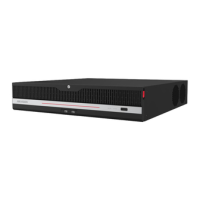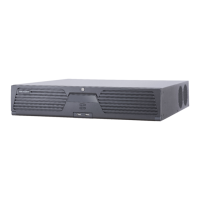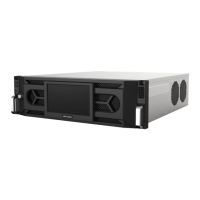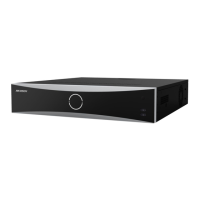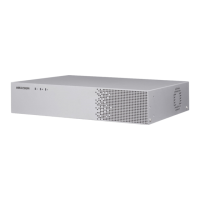Do you have a question about the HIKVISION iDS-9664NXI-I8/16S and is the answer not in the manual?
| Model | iDS-9664NXI-I8/16S |
|---|---|
| Video Input Channels | 64 |
| Video Compression | H.265+/H.265/H.264+/H.264 |
| Recording Resolution | Up to 12MP |
| Alarm In/Out | 16/4 |
| Operating Humidity | 10% to 90% (non-condensing) |
| Type | Network Video Recorder |
| Max Resolution | 12MP |
| Decoding Capability | 64-ch@1080p (30 fps) |
| Audio Output | 1-ch (RCA) |
| Video Output | HDMI, VGA |
| HDMI Output Resolution | 4K (3840 × 2160)/30Hz |
| VGA Output Resolution | 1920x1080 |
| HDD Slots | 8 |
| HDD Capacity | Up to 16TB for each HDD |
| Network Interface | 2x 10/100/1000 Mbps Ethernet |
| USB Interface | 2 × USB 3.0 |
| Power Supply | 100-240 VAC, 50/60 Hz |
| Power Consumption (without HDD) | ≤ 45 W |
| Operating Temperature | -10°C to +55°C |
| Dimensions (W × D × H) | 440 × 440 × 88 mm |
| Weight (without HDD) | ≤ 8 kg (17.6 lb) |
Provides essential safety guidelines for device operation and maintenance.
Guides on activating the device using different methods.
Explains how to configure network settings for TCP/IP.
Details the process of configuring Hard Disk Drives (HDDs).
Instructions for adding network cameras to the system.
How to begin viewing live camera feeds.
Customizing live view parameters like output interface and dwell time.
Arranging camera feeds in custom layouts for live view.
Accessing real-time facial recognition and stranger recognition results.
Controlling Pan, Tilt, and Zoom (PTZ) functions of cameras.
Configuring video recording parameters and schedules.
Methods for playing back recorded video files.
Performing various operations during video playback.
Configuring standard event alarms like motion and video loss.
Handling Video Content Analysis (VCA) events from cameras.
Processing temperature measurement results from thermography cameras.
Detecting density of human bodies exceeding a set value.
Detecting objects left unattended in a region.
Detecting objects removed from a predefined region.
Detecting events like fire, smoke, or temperature from thermal cameras.
Setting time periods for event detection to be active.
Configuring actions to be taken when an alarm or exception occurs.
Configuring VCA (Video Content Analysis) engines for working modes.
Managing and enabling smart analysis tasks for cameras.
Configuring face comparison alarms and capture based on recognition.
Selecting face pictures based on pupil distance, tilt, and pan angles.
Capturing faces appearing in the surveillance scene.
Storing and managing face pictures for comparison.
Triggering alarms when detected faces match library entries.
Triggering alarms for individuals appearing at high or low frequencies.
Setting up perimeter protection features like line crossing detection.
Detecting objects crossing a set virtual line.
Detecting objects entering and loitering in a predefined virtual region.
Detecting objects entering a predefined virtual region.
Detecting objects exiting a predefined virtual region.
Detecting and capturing human bodies in the monitoring scene.
Detecting human bodies and capturing their pictures.
Searching for human body pictures by detection alarms or appearance.
Detecting faces, human bodies, and vehicles simultaneously.
Detecting vehicles for road traffic monitoring.
Setting up vehicle detection rules and lane configurations.
Identifying events of objects being thrown from buildings.
Achieving smart, facial, vehicle, and human body detection.
Counting people entering or leaving configured areas.
Searching for face pictures by comparison events or uploaded images.
Adding Internet of Things (IoT) devices like access control and alarms.
Specifying conditions to search for videos and pictures.
Searching human body, face, and vehicle files.
Managing storage devices like SSDs and HDDs.
Initializing and managing Solid State Drives (SSDs).
Configuring HDD groups and properties.
Creating and managing disk arrays (RAID).
Creating disk arrays using one-touch or manual configuration.
Setting up Dynamic DNS service for network access.
Setting up port mapping (NAT) for remote access.
Managing user accounts, permissions, and MAC addresses.
Assigning local and remote operating permissions to users.
Steps to add new user accounts with specified levels and permissions.
Assigning specific operating permissions to user accounts.
Setting up security questions and GUID files for password recovery.
Procedures for resetting forgotten passwords.
Resetting the password using a GUID file.
Resetting the password by answering security questions.
Resetting the password using a reserved email address.
Resetting the password using the Hik-Connect app.
Performing maintenance on storage devices.
